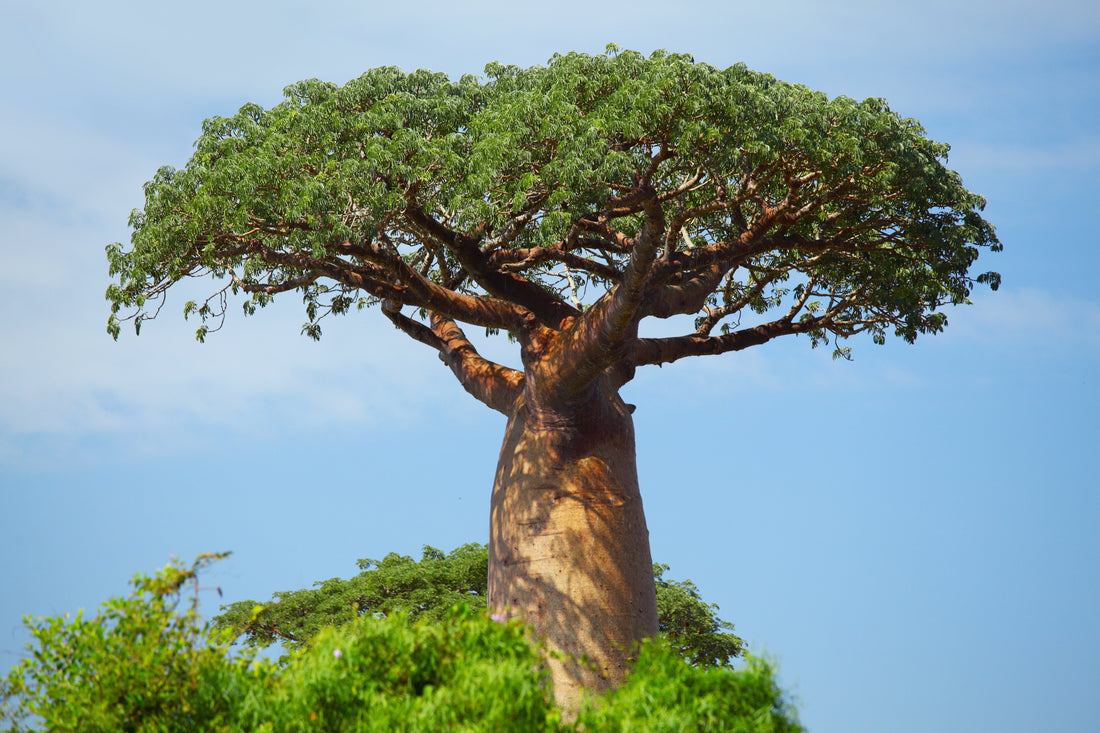
What is Baobab Fiber?
Share
If you are lucky enough to spot a baobab in the wild, you’ll immediately see why these trees are so revered. Native to sub-Saharan Africa, as well as parts of Australia and India, some of them are more than 3,000 years old! They grow as tall as a six-story building, with a diameter of 40 feet or more! Their trunk is hollow and the tree only bears leaves for a short time. The rest of the year, they seem to have been uprooted and replanted upside-down. Plenty of legends try to explain its unique appearance and significance.
Nicknamed the “tree of life,” the baobab tree bear green oval-shaped fruit with large white blossoms that dangle from the branches. The leaves are eaten like spinach and have been used in African herbalism and traditional medicine. Elephants feast on the trunk when water is in short supply – one large tree can store up to 4,500 liters of water! The fruit is considered by many to be the greatest raw food on the planet. We use baobab fiber in our new Fasting Today® intermittent fasting drink mix. Read on to learn why baobab can’t be beat!
What is Baobab and What are Its Benefits?
Baobab (Adansonia digitata) is a tree that is widely used and beloved in its native habitats (and of late, those habitats have also been impacted by climate change). The leaves, wood, bark, seeds and fruit all have their own traditional uses. Humans eat the young leaves, rich in vitamin C, like spinach. The fruit has a tangy citrus taste, and it’s made into a drink. The seeds are eaten fresh or dried, and they can also be roasted as an ersatz coffee.
Back in 2008, the European Union was approved as an ingredient for foods, and its global appeal has spread since then. You can find baobab in cosmetics, skin care products, supplements and as dried powder (since the fruit is only available fresh for a very short period of time).
We use organic baobab that was sustainably harvested in Africa. We work with suppliers who aid women harvesters – who make up 70% to 98% of the supply chain – and positively support their small communities. In some areas of South Africa, the sales of baobab fruit has increased monthly cash income by 250%, allowing the women to pay for education, food, healthcare and more for themselves and their families.
Here are some of the benefits of baobab:
- A good source of many essential vitamins and minerals, including vitamin C, potassium, magnesium, iron and zinc.*
- Also an abundant source of polyphenols.*
- Supports digestion of starch and the body’s natural glycemic response.*
- Promotes feelings of fullness and satiety.*
- Rich in fiber (both soluble and insoluble) to support hunger and regularity.*
- The FODMAP-friendly (IYKYK!) fiber may act as a prebiotic.*
The Benefits of Fiber*
So many Americans fall short on reaching their fiber goals that it is often called a “nutrient of concern.” Experts call this the “fiber gap,” because only about 5 of every 100 adults get enough. Women ages 19 to 50 should consume about 25 grams daily, while men need 38 grams, according to the 2015-2020 Dietary Guidelines for Americans.
Fiber offers plenty of benefits that you miss out on when you don’t get enough: It can promote regularity, satisfy hunger and beat belly bloat.* Consuming adequate amounts of fiber can help support heart health, gut health, mood and more.*
Here’s a closer look at three of those benefits:
Supports regularity*
Fiber promotes normal, healthy and comfortable bowel movements.* Fiber adds bulk and volume to stool and makes it easier to have a BM. Eating patterns that are high in certain fibers can promote bowel regularity and other aspects of GI health.*
Helps reduce hunger.*
Fiber has zero calories, but it is naturally filling. It promotes a feeling of satiety or fullness, to support your overall diet and manage hunger.* Food is fuel, and certain nutrients are digested faster than others. Meanwhile, fiber slows down that process – it’s like pumping the brakes after you eat, so that you feel fuller for longer.
Fiber can help boost satiety hormones that keep you feeling full, like cholecystokinin, while helping lower levels of hunger hormones like ghrelin.
Prebiotic properties support probiotics*
Prebiotic fiber delivers the food that probiotics need to maintain a healthy balance of beneficial flora in the gut.* This helps support your digestion.*
You’ll find baobab fiber in our new drink mix. Fasting Today® is formulated to not break your fast! With three essentials in one convenient product, it includes electrolytes, baobab fiber and the nine essential amino acids. Simply shake a scoop with 12 ounces of water, then drink up and carry on with your fast.
Fasting Today supports hydration, reduces hunger and promotes muscle health.*

